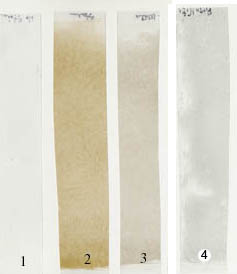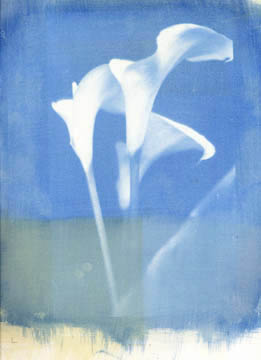
Sometimes after a print is developed, there is a lingering yellow, tan or brown stain that sullies the colors and/or the background, consisting of hexavalent (yellow) or reduced (other colors) chromium remaining on the print. The hexavalent dichromate stain is less common, since hexavalent (unreduced) dichromate usually washes out of the print easily, but once in a while a particular paper or size or combination thereof will trap the yellow color and hold it in the paper through the development. I also suspect that once or twice when I encountered this, it was because I didn't let the sized paper dry long enough before printing on it.
All variations of dichromate stain can be removed by placing the print in a bath of sodium bisulfite or potassium metabisulfite, 5%, after drying, for 5 minutes. My side by side tests comparing sodium bisulfite to potassium metabisulfite, which I won't bother to show here, showed no difference between the two clearing agents as to effectiveness of clearing, speed of clearing, softening of the gum, or odor. I use whichever one I happen to have on hand. Sodium sulfite can also be used in a pinch, but it took longer, more like an hour, to clear, in the one test I did with it, instead of 5 minutes.
There has been some confusion introduced by gum printers expressing a preference for one bisulfite over another, (one person even announced, "I find potassium metabisulfite infinitely superior to sodium bisulfite" but according to chemists I've consulted as well as my own tests, functionally and chemically they are the same, and there's no reasonable basis for claiming superiority for one over the other.
Here's a visual that shows what gum looks like when it's not stained, when it's stained, and when the stain is treated with a clearing agent. I've used unpigmented gum so you can see what gum looks like in these various states by itself.

All of the above samples are unpigmented dichromated gum on mylar, exposed and developed.
1. Crosslinked gum, exposed for optimum hardening without stain. (My tests, and some earlier research as well, show that further exposure doesn't produce more hardened gum, just more stain, so exposing to the point of stain isn't productive in terms of making a thicker layer of hardened gum). You can't actually see the gum in this sample, because it is colorless and clear, invisible to the scanner. What you see here is the slight greyish color of the scuffed mylar and the white background of the scanner lid behind, viewed through the clear gum.
2. Gum deliberately overexposed in the sun til stained brown with dichromate stain, then placed in water until there was no more evidence of loss of fresh dichromate, plus 20 more minutes for good measure.
3. Stained gum as in 2, left in water for 12 hours. The water was quite clear and colorless at the end, but the lengthy soak had faded the stain to a considerable extent.
4. Stained gum as in 2, placed in 5% potassium metabisulfite for 5 minutes and well washed before drying. Printing without pigment reveals that clearing produces a bluish-grey dingy color rather than clear gum as in 1. The lighter patches are where the clearing agent lifted the gum from the substrate.
The purpose of this visual is to show that (1) crosslinked gum has no color in and of itself, (2) dichromate stain will result from excess exposure. Dichromate stain comes in different colors, but is usually tan or brown. (3) the dichromate stain can be cleared using a clearing agent such as potassium metbisulfite, but that the cleared gum won't be as clear as gum that was never stained to start with, but will tend to a bluish grey cast.
Some authors insist that all prints should be cleared, even when dichromate stain is not apparent, because even small amounts of the stain will compromise the paper. Since we don't know what dichromate stain is, chemically, there isn't any way whether we could know if its presence would compromise paper. You can clear if you want to, just in case, but I've never worried about it. As I said above, I rarely encounter dichromate stain, and I never clear except in the rare occasions that I do encounter it.
Sometimes a particular paint will be susceptible to dichromate stain: here's an example of dichromate stain that I encountered when testing a Linel white gouache:

The gum containing the white gouache covers only the lower portion of the image (I was experimenting with overprinting an image with white, using a rejected print to experiment on); the stain has been left on the left portion so you can see it, and cleared from the right portion with a clearing agent, so you can see what the white gum looks like without the stain.
Copyright Katharine Thayer; all rights reserved.